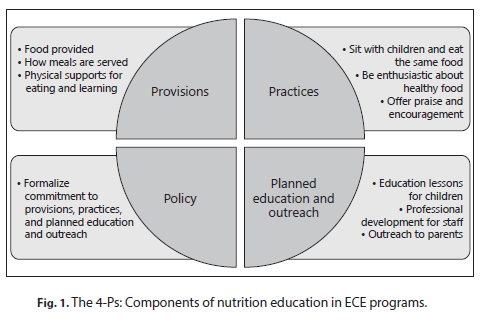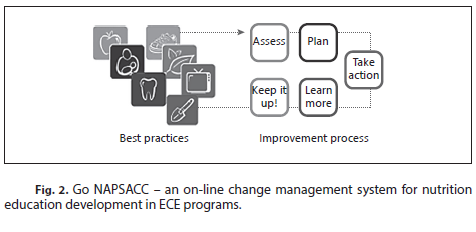Multi-Level Opportunities to Improve Nutrition Education in Childcare Settings
Early childhood, from birth to age 5, is a critical period for growth and development. Lifelong dietary habits are being formed, which in turn affect immediate and long-term health, including risk of cardiovascular disease, obesity, and diabetes [1]. Eating a healthful diet and developing a positive relationship with food sets children on a pathway to a lifetime of good health. Unfortunately, poor dietary habits are common among today’s young children [2].
Early care and education settings (ECE) have the potential to exert considerable influence on the eating habits of young children. In the US and most other countries, ECE programs serve large numbers of children. Enrolled children spend 32–36 hours per week and consume 50–75% of their daily caloric intake while in childcare [3].
ECE programs can support children’s development of healthy eating habits through nutrition education, defined as a comprehensive, multi- level approach including education, environmental support, and policy [4]. A useful mnemonic when describing the multiple opportunities for nutrition education in ECE programs is the 4-Ps, which refers to provisions, practices, planned education and outreach, and policy. Explanation and examples of the 4-Ps are presented in Figure 1.
Provisions refer to the facilities, services, amenities, and resources offered by the ECE program in support of children’s nutrition. Specific examples include the food and beverages served; how meals and snacks are provided to children; and the physical support for eating (e.g., child-size utensils), learning (e.g., books and posters), and hands-on experiences (e.g., gardens and play kitchens). When children are served healthful food, allowed to serve themselves, and are reinforced by a physical environment that respects food and its importance, they develop a lifelong appreciation for healthy food.
Practices refer to the relationship teachers and other staff establish with the children around food and eating. Teachers and staff can support healthy eating by sitting with the children during meals, eating the same food, using enthusiastic language to talk about healthy food, and offering praise and encouragement when children try new or less familiar food.
Planned education and outreach includes formal nutrition lessons for children, professional development for staff, and engaging families in the support of healthy eating. Nutrition lessons can be stand-alone educational sessions about a nutrition topic or integration of nutrition concepts with other learning standards. Professional development builds necessary knowledge and skills needed to support children’s nutrition, but can also be beneficial for the staff ’s own nutrition education. Outreach to parents should foster partnership between ECE and home to ensure that children receive consistent nutrition messages.

Policies are written plans or course of action that govern how ECE programs operate. By formalizing policies in written documents and sharing those with families and the public at-large, ECE programs solidify their commitment to children’s nutrition education. Most ECE programs fail to implement the full range of best practices possible to provide optimal nutrition education.
An example of an effective strategy for improving ECE program’s nutrition education is Go NAPSACC – an online, interactive, change management system that provides a suite of tools that guide ECE programs through continuous quality improvement [5]. Go NAPSACC’s 5-step change process encourages reflecting on current nutrition practices, setting goals and planning for action, taking that action, obtaining education and training, and revising/ repeating the process (Fig. 2).
An important “call to action” directed at nutrition experts, health professionals, and policy-makers encourages them to support ECE programs in the implementation of a comprehensive nutrition education program that supports young children and their families.

Reference
1. Mozaffarian D: Dietary and policy priorities for cardiovascular disease, diabetes, and obesity: a comprehensive review.Circulation 2016;133:187–225.
2. Welker EB, Jacquier EF, Catellier DJ et al: Room for improvement remains in food consumption patterns of young children aged 2-4 years. J Nutr 2018;148:1–11.
3. American Dietetic Association: Position of the American Dietetic Association: Benchmarks for nutrition programs in child care settings. J Am Diet Assoc 2005;105:979–986.
4. Contento IR: Nutrition Education: Linking Research, Theory, and Practice (ed 3). Burlington, Jones & Bartlett Learning, 2016, pp 1–638.
5. Ward DS, Vaughn AE, Mazzucca S, Burney R: Translating a child care based intervention for online delivery: development and randomized pilot study of Go NAPSACC. BMC Public Health 2017;17:891.
Full article coming soon